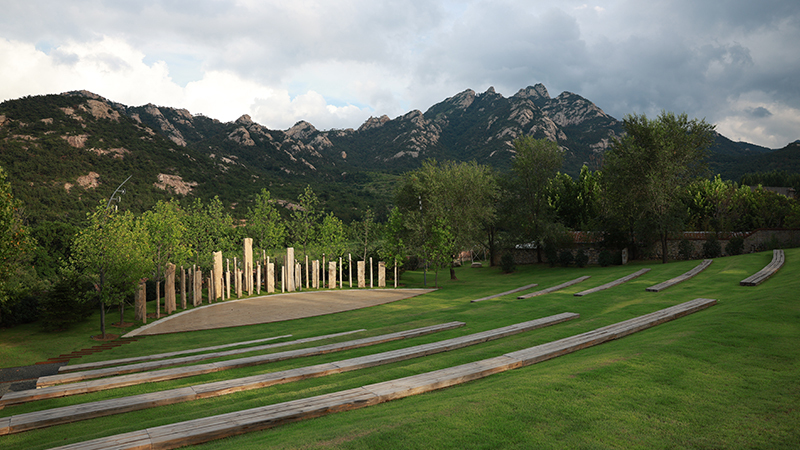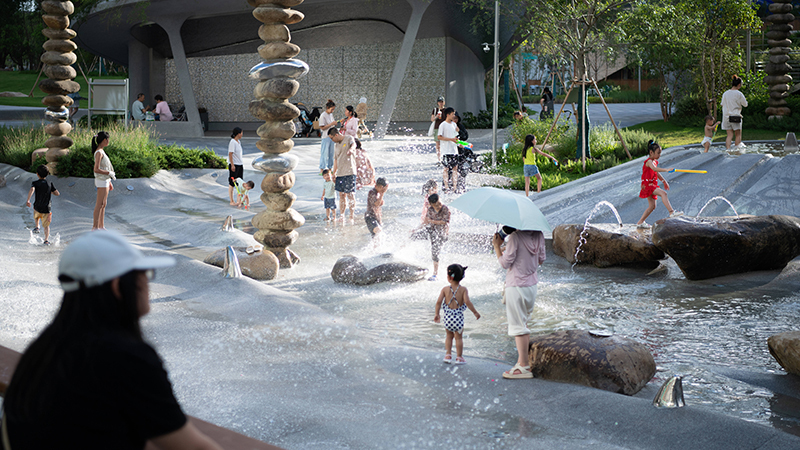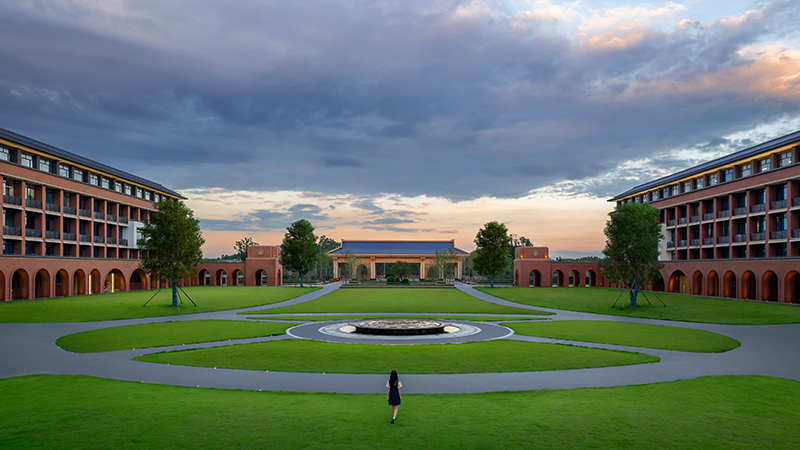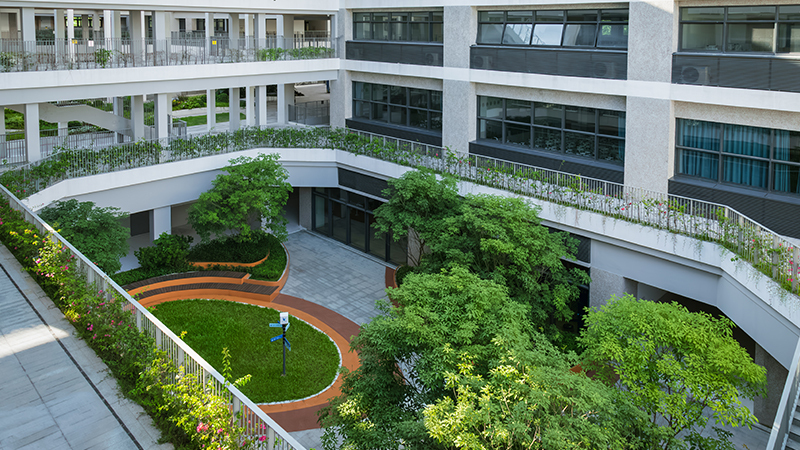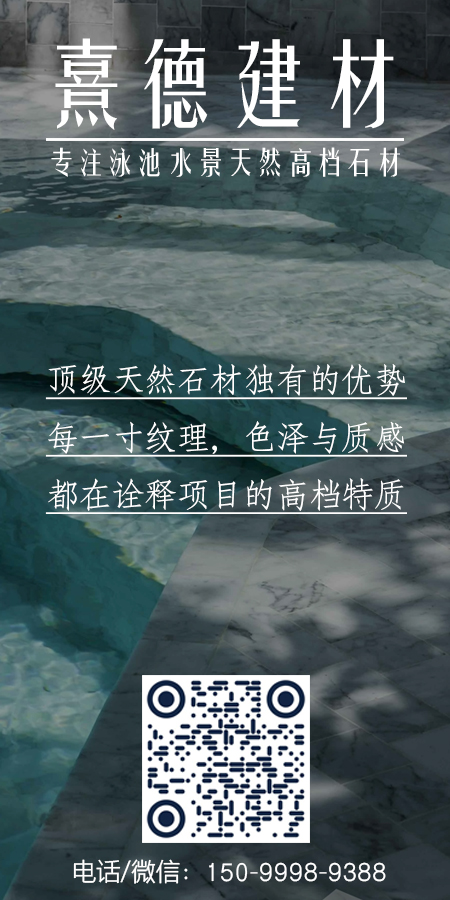公立校园项目一直是大小景观既憧憬又敬畏的类型。憧憬,源于我们大多亲历过传统校园环境的种种不足,始终希望借设计之力,改善传统校园空间的局限,为学生营造更开放、亲切、富有活力的环境。敬畏,则因其在公共项目中具有独特属性:不仅规范严苛、流程复杂,且景观往往属于边缘专业,话语权有限。更现实的是,校方需求常常在施工甚至临近竣工时才最终敲定,诸如增设功能设施、调整门禁系统等临时变化,使项目充满不确定性与应变压力。
Public school campus projects have always been a type that Atelier Scale both aspires to and approaches with reverence. Our aspiration stems from firsthand experience with the many shortcomings of traditional campus environments—we’ve long hoped to harness the power of design to improve these limitations and create spaces that are more open, welcoming, and full of vitality for students. Our reverence, however, comes from the unique challenges these public projects present: strict regulations, complex procedures, and a marginal role for landscape, which often has limited influence in the decision-making process. More pragmatically, school-side requirements are often finalized only during construction—or even near completion—with last-minute changes such as the addition of functional facilities or revisions to access control systems. These constant shifts make the process highly uncertain and demand a high degree of adaptability.
"无界花园"这个校园项目历时三年,这使得我们有幸与建筑师能够全程紧密协作,从最初的概念畅想到最终的落地呈现,共同完成了一次关于理想校园的真诚探索。
The Infinity Garden campus project spanned three years, allowing us the rare opportunity to collaborate closely with the architects throughout the entire process—from the initial conceptual vision to the final built outcome. Together, we completed a sincere exploration of what an ideal campus could be.
大多数校园为了提高教学效率与管理便利,环境设计趋向标准化与功能化,自然、艺术与运动这三类对儿童成长至关重要的内容,往往被忽视。“自然”被简化为可控绿地,缺乏真实的自然体验;“艺术”因难以量化与安全顾虑,被视为可有可无;“运动”虽有规范保障,但场地设计同质,孩子们的自由活动也受限。我们希望通过设计,让校园重新拥有自然的气息、艺术的表达和自由的运动空间。
To improve teaching efficiency and ease of management, most campuses tend to adopt standardized and utilitarian approaches in environmental design. As a result, three elements vital to children's development—nature, art, and physical activity—are often overlooked. “Nature” is reduced to manageable green spaces, lacking authentic natural experiences; “art” is seen as dispensable due to its intangible value and safety concerns; and while “sports” are institutionally supported, the facilities are often uniform in design, leaving little room for free play. Through our design, we hope to restore to the campus a sense of natural presence, artistic expression, and spaces for unstructured physical activity.
建筑格局与协同设计
Architectural Layout and Collaborative Design
“无界花园”位于深圳华富村(华富村建成于上世纪80年代的,是一片几乎与深圳同龄的社区,同时也是深圳福田区首个棚改城市更新项目)一座新建的九年一贯制学校的校园中,校园建筑营造出了紧凑且复合的空间,为54个班级的学生学习提供了良好的学习环境。
Infinity Garden is located within the campus of a newly built nine-year continuous education school in Shenzhen’s Huafu Village (a community established in the 1980s, nearly as old as Shenzhen itself, and also the first urban renewal project involving shantytown redevelopment in Futian District). The campus architecture creates compact and multifunctional spaces, providing a good learning environment for students across 54 classes.
校园建筑总体布局将校舍、户外配套和景观三位一体综合考虑,并通过与景观的互动,组织出有秩序的空间布局,创造了校区安静舒适的空间体验。建筑主体集中在校园北侧,南侧空出充足的完整的活动空间,与操场共同组成了更加充裕的活动场所;即便是负一层,建筑也为采光留出了楼板镂空,进而产生诸多的庭院;二层甲板的预留,为室外营造自然与活动场地,带来了更灵活的空间。
The overall campus architectural layout integrates the school buildings, outdoor facilities, and landscaping into a cohesive whole. Through interaction with the landscape, it organizes an orderly spatial arrangement, creating a quiet and comfortable campus experience. The main buildings are concentrated on the north side of the campus, leaving ample, uninterrupted activity space on the south side. Together with the playground, this forms a more spacious area for activities. Even on the basement level, the design includes floor openings to allow natural light in, creating numerous courtyards. The reserved deck on the second floor provides outdoor spaces that blend nature with activity areas, offering more flexible environments.
尽管场地紧凑,建筑师依然预留了中庭、露台、架空层以及楼层转换处等诸多空间,便于与我们联手创造更多可营造自然的可能。自然的主题构建,涵盖了从地下二层、一层至顶楼的各个院落口袋、平台顶板甚至建筑的立面,为师生们的各种公共活动带来了美妙的花园。
Despite the compact site, the architects still reserved numerous spaces such as courtyards, terraces, open-air levels, and floor transitions, facilitating our collaboration to create more opportunities for integrating nature. The theme of nature is expressed throughout—from the second basement level and the ground floor to the rooftop courtyards, pocket gardens, platforms, and even the building facades—bringing wonderful garden-like environments for various public activities enjoyed by both teachers and students.
景观通过充分激活建筑预留的一系列非室内留白空间,将它们转换成陪伴学生成长的花园。同时,受到建筑空间的启发,我们不希望硬生生地将建筑室内与景观室外划分出生硬的边界,而是让景观是流动的、暧昧的,并且模糊了室内与室外的关系,将校园环境串联成一个既整体又多元的体系。借由建筑打下的丰富的三维空间的基础,最大化的创造最亲近自然和最富体验性的环境,将校园营造成一座“无界花园”,这也是景观的设计初衷与最大愿景。
The landscape design fully activates a series of intentionally left blank spaces within the architecture, transforming them into gardens that accompany students as they grow. Inspired by the architectural spaces, we sought to avoid rigidly dividing the indoor building areas from the outdoor landscape. Instead, the landscape is designed to be fluid and ambiguous, blurring the boundaries between inside and outside. This approach connects the campus environment into an integrated yet diverse system. Building on the rich three-dimensional spatial foundation established by the architecture, we maximized the creation of environments that are closest to nature and richest in experience, shaping the campus into an “Infinity Garden.” This vision represents the original intention and ultimate aspiration of the landscape design.
让绿色不再是点缀
Let greenery no longer be just an decoration
在植物设计方面,我们的初心是让学生在日常学习生活中能够有机会与植物建立亲密的对话,并通过触手可及的自然体验唤醒生态认知。设计中我们突破传统校园追求秩序感的绿化范式,以立体渗透的手法让建筑与自然共生——绿色不再是点缀,而是成为包裹、穿插、渗透空间的有机生命体。
In terms of planting design, our original intention is to give students the opportunity to engage in intimate dialogue with plants during their daily learning and life, awakening ecological awareness through accessible natural experiences. In our design, we break away from the traditional campus greenery paradigm that prioritizes a sense of order. Instead, we use a three-dimensional, permeating approach to create symbiosis between architecture and nature—where greenery is no longer just an embellishment but becomes an organic living presence that envelops, interweaves, and penetrates the space.
根据场地的条件,我们的植物设计主要有两种模式:采光受限区域,构建以叶形肌理为特色的阴生植物群落;采光充足区域,凸显多样性与丰富立面层次的植物搭配。
Based on the site conditions, our planting design follows two main patterns: in areas with limited sunlight, we create shade-loving plant communities characterized by distinctive leaf textures; in well-lit areas, we emphasize plant diversity and richness to enhance the layers of the façade.
采光充足的区域,主要在二层,设计将关注点放在植物的多层次、多品种搭配上,营造贴近自然的植物空间,寓学习于自然之中。
The well-lit areas are mainly on the second floor, where the design focuses on layering and combining a variety of plant species to create a naturalistic plant environment, allowing learning to take place immersed in nature.
采光受限区域,主要在负一层,绿化空间由多个绿岛构成,整体选用色彩丰富、叶形纹理独特的耐阴植物,打造多层次、艺术化的绿岛空间。我们希望每个绿岛各有不同,其中由建筑环绕形成采光天井最深处的绿岛,选择塔形树冠的锦叶榄仁,金黄色叶片轻盈层叠,打破天井深处的沉闷感。上层选择高瘦的白兰引导垂直视线,中下层种植识别度很高的大叶植物香蕉树、天堂鸟,搭配半耐阴的开花植物和彩色大叶植物(如赤苞花、梦幻朱蕉、彩叶芋等),丰富下层空间,围合出一个安静且有趣味的口袋,便于学生停留。
The areas with limited sunlight are mainly located on the basement level, where the green spaces are composed of multiple green islands. These islands are planted with shade-tolerant species featuring rich colors and distinctive leaf textures, creating multilayered, artistic green islands. We aim for each green island to be unique. For example, the island situated in the deepest part of the light well, enclosed by the building, features the tower-shaped canopy of the golden-leaved Terminalia catappa. Its light, layered yellow leaves break the gloominess of the deep well. Taller, slender Michelia alba trees guide the vertical sightline on the upper layer, while large-leafed, highly recognizable plants like banana trees and bird of paradise fill the middle and lower layers. These are paired with semi-shade-tolerant flowering plants and colorful foliage plants—such as red-leaf poinsettia, Cordyline fruticosa, and caladium—to enrich the lower levels. Together, they enclose a quiet yet playful pocket space that encourages students to linger.
但能成为绿化空间的场地极为有限,即便在艰难争取到的绿化区域,覆土条件也受到严格制约。因此,我们采用竖向空间和视觉感受来提升整体的绿量感与自然氛围,以弥补绿化空间的不足。
However, the sites available for green spaces are extremely limited. Even in the hard-won planting areas, soil depth and conditions are strictly constrained. Therefore, we use vertical space and visual perception to enhance the overall sense of greenery and natural atmosphere, compensating for the lack of planting area.
自然花园
Nature Garden
鉴于建筑的格局,我们创造了三个花园体系:自然花园、健康花园、艺术花园。自然花园流动于建筑的立体空间之间,是一个漂浮于多层建筑楼板之上的绿色体系。
Given the architectural layout, we created three garden systems: the Nature Garden, the Health Garden, and the Art Garden. The Nature Garden flows through the three-dimensional spaces of the building, forming a green system that seems to float above the multiple building floors.
由于自然花园处在建筑结构顶板之上,种植条件受到了结构顶板到完成面高度、承重等硬性条件的限制。我们通过与建筑和结构专业的积极协调,为景观争取到了多个颇具使用价值的空间节点,如:面向自然观察的峡谷花园“科普口袋”、围绕现状乔木布置的“树桌口袋”、满足教学需求的“阶梯课堂”以及被绿色包裹的“自然之心”。这些空间不仅提供了亲近自然的可能,也成为校园生活的延展。
Because the Nature Garden is situated above the building’s structural roof slab, planting conditions are constrained by rigid factors such as the height from the slab to the finished surface and load-bearing capacity. Through active coordination with the architecture and structural engineering teams, we secured several highly functional spatial nodes for the landscape design, including: the canyon garden “Science Pocket” oriented for nature observation; the “Tree Table Pocket” arranged around existing mature trees; the “Terraced Classroom” designed to meet teaching needs; and the “Heart of Nature,” enveloped in greenery. These spaces not only offer opportunities for close contact with nature but also serve as extensions of campus life.
科普口袋:以趣味树岛群落为核心,顺滑流畅的种植池外壁如同水流冲刷过的小岛,围合出饶有趣味的峡谷地貌,穿梭期间嬉笑玩闹,自然天真。树岛与种植区通过观花乔木、浆果灌木及香草植物分片区组合,形成可触摸的自然生境,引导学生在绿岛间认知植物季相变化与生物链关系。
Science Pocket centers around a playful cluster of tree islands, with smoothly flowing planting bed edges resembling small islands shaped by water currents, enclosing an engaging canyon-like landscape. As students move through it, they laugh and play freely, naturally and innocently. The tree islands and planting areas are divided into zones featuring flowering trees, berry shrubs, and aromatic herbs, creating a tactile natural habitat that guides students to learn about plant seasonal changes and food chain relationships as they explore the green islands.
在种植设计策略上,我们根据梁柱点位种植了骨架乔木秋枫,常绿小乔木柚子则构成了背景林冠,开花小乔风铃木和多种开花灌木丰富了中层,多样的地被植物吸引了鸟类和昆虫,打造微生态环境,创造出学生与自然的交互空间,同时选择与教材联系较密切的植物(如角茎野牡丹、龙吐珠、迷迭香、栀子花、蜘蛛抱蛋等),打造室外科普教室。
In our planting design strategy, we planted structural trees like autumn maples at beam and column points, while evergreen small trees such as pomelo form the background canopy. Flowering small trees like the trumpet tree and various flowering shrubs enrich the mid-layer. A diverse mix of ground cover plants attracts birds and insects, creating a micro-ecological environment and interactive space for students to engage with nature. Additionally, we selected plants closely related to the curriculum—such as wild peony, coralberry, rosemary, gardenia, and spider eggplant—to create an outdoor science classroom.
树桌口袋:我们希望创造一个位于“绿伞”庇荫之下的户外学习空间,乔木与桌子相结合,形成绿色上层覆盖,趣味开花地被(如猫尾红、虾夷花等)混合种植在圆形种植槽,为学生提供亲近自然的阅读、作业场地。项目建成后,孩子们开发出很多在我们意料之外的更加有趣的使用方式。
Tree Table Pocket: We aimed to create an outdoor learning space nestled under the shade of a "green umbrella," where trees and tables combine to form a leafy upper canopy. Playful flowering ground covers—such as foxtail millet and Ezo flowers—are mixed in circular planting beds, providing students with a natural, inviting spot for reading and doing homework. After the project’s completion, the children discovered many unexpectedly fun ways to use the space.
阶梯课堂:在3F的建筑回廊打开一个较大的口部,向下延伸出宽阔的交通阶梯,就着阶梯,景观设想了一个结合家具的户外教室,可穿行、可停留阅读,也可作为班级的集体展讲区。
Terraced Classroom: On the 3rd floor building corridor, a large opening extends downward into a wide staircase. Alongside the steps, the landscape design envisions an outdoor classroom integrated with furniture—allowing movement, quiet reading, and serving as a collective presentation area for classes.
勒杜鹃台地:建筑师为了给与-1层的健身活动区更高的层高与更好的采光,做了跌级上旋的钢构架,景观提资种植所需荷载并巧妙结合园建高差变化,混植多色深圳市花簕杜鹃,强化设计造型语言,营造一个多彩的阶梯式花园。
Le Rhododendron Terrace: To provide the fitness area on the basement level (-1) with higher ceiling heights and better natural light, the architects designed a stepped, spiraling steel structure. The landscape team contributed by supplying the necessary planting load capacity and cleverly integrating the garden’s elevation changes. They planted a mix of multicolored Bougainvillea, Shenzhen’s city flower, to enhance the design’s visual language and create a vibrant, terraced garden.
自然之心:曲面建筑的内走廊与楼栋连板连接而成形成了一处巨大的采光天井,建筑预留的双层种植槽为景观给建筑穿上绿色外衣提供了绝佳的条件。我们希望天井的立面被绿色包裹,形成坐落在葱郁之中的多层次生态绿墙,因此植物设计依托建筑曲面边界的立体空间,并借助采光天井的垂直结构与双层种植槽。鉴于校园景观的特殊性,植物设计需要满足校方“简洁、干净、低维护”的要求,因此在布局和品种选择上,我们全部采用华南本土植物,并控制层次以利于后期修剪维护,同时确保所选品种具有视觉冲击力。得益于深圳舒适的亚热带气候,这里的植物能够全季节生长,冬季也能保持常绿。
Heart of Nature: The curved building’s balcony corridor connects with the building slab to form a large light well. The architect’s provision of double-layer planting beds offers an excellent opportunity for the landscape design to cloak the building in greenery. We aimed for the light well’s vertical surfaces to be wrapped in lush, multi-layered ecological green walls nestled within abundant foliage. Therefore, the planting design relies on the three-dimensional spatial boundaries of the building’s curves and utilizes the vertical structure of the light well and the double-layer planting beds. Considering the special nature of campus landscapes, the planting design needed to meet the school’s requirements for “simplicity, cleanliness, and low maintenance.” Thus, in layout and species selection, we used only native South China plants, controlled layering to facilitate future pruning and maintenance, while ensuring the chosen species deliver strong visual impact. Thanks to Shenzhen’s comfortable subtropical climate, the plants thrive year-round, remaining evergreen even in winter.
根据种植槽与采光天井的光照差异,在光照充足上层区域种植低维护的耐晒地被,如银边山菅兰,主视线区域种植多色簕杜鹃和蓝雪花,垂挂开花形成彩色韵律。光线较差的下层区域,以天南星科为主的大叶片耐阴植物为主,垂状层叠的大叶片增加了葱郁感。此外,我们通过韵律感穿插种植了光耀藤,光耀藤生长迅速且耐修剪,很快便如绿瀑一般垂下来,这种韵律也控制着光影节奏,从建筑走廊望去,则会看到阳光透过轻盈的光耀藤,像是给建筑披了一层绿色的轻纱。我们希望师生穿梭在走廊时,往外瞥一眼便是绚烂多彩与绿意盎然,站在天井中央抬头仰望时,枝叶与天空交织,实现从地面至空中的绿意渗透和建筑内外的绿色流动。这一布局既呼应了天井自然光的梯度变化,满足植物生长需求,又通过蒸腾作用调节微气候,缓解高密度校区的热岛效应,通过景观,将建筑转化为"会呼吸的生命体",更以可持续的生态界面重新定义了校园公共空间的温度与活力。
Based on the lighting differences between the planting beds and the light well, the well-lit upper areas are planted with low-maintenance, sun-tolerant ground covers like variegated lilyturf, while the main visual zones feature multicolored Bougainvillea and Plumbago that hang and bloom to create a colorful rhythm. The shadier lower areas are dominated by large-leaved, shade-tolerant Araceae plants with cascading foliage that enhances the lushness. We also rhythmically interspersed fast-growing, easily trimmed Mandevilla vines that cascade like green waterfalls, filtering sunlight through the corridors and draping the building in a delicate green veil. This design lets teachers and students experience vibrant greenery and color as they move through the campus, with foliage seamlessly blending with the sky when looking up from the light well. It responds to the natural light gradient to support plant growth, regulates the microclimate through transpiration to mitigate urban heat island effects, and transforms the building into a “breathing” living organism that sustainably redefines the campus public space’s temperature and vitality.
健康花园
Health Garden
健康花园位于建筑的首层,是校园生活中最活跃、最开放的空间。它由操场、多功能活动区、中学部健身花园及与之紧密相连的架空层构成。
The Health Garden is located on the building’s first floor and serves as the most active and open space in campus life. It consists of the playground, multifunctional activity areas, the middle school fitness garden, and the closely connected elevated space underneath the building.
首层空间承担着重要的集散功能,因此在设计中,我们尤其关注如何在不影响通达效率的前提下,拓展学生自由活动的可能性。操场南侧的缓坡草坪与看台式坐阶,提供了既可观演又可休憩的多功能空间。架空层下设置了跳远道、攀爬墙、跑酷道具等设施,在天气不佳时也能保证户外运动。植物配置上,上层乔木疏朗轻盈,保证场地的通透性,下层地被规则搭配种植于校园家具上,不影响孩学生的攀爬和穿梭。
The first-floor space serves an important role as a circulation hub, so in our design, we focused especially on expanding opportunities for students’ free activities without compromising accessibility and flow. On the south side of the playground, a gently sloping lawn and stepped seating provide a multifunctional area for both viewing and resting. Beneath the elevated structure, facilities like a long jump track, climbing wall, and parkour equipment ensure outdoor exercise can continue even in bad weather. The planting design features sparse, lightweight upper-layer trees to maintain openness, while the lower-layer ground covers are neatly arranged on campus furniture, allowing children to climb and move freely without obstruction.
健康花园通过地形、设施、标识的综合设计,引导学生进行多样化的自主运动——从快速奔跑、跳跃,到攀爬、平衡练习。相比传统体育课的规则化训练,这些非正式的“边角空间”反而更能激发学生身体的活力与探索的热情。
The Health Garden guides students to engage in diverse self-directed physical activities—ranging from sprinting and jumping to climbing and balance exercises—through integrated design of terrain, facilities, and signage. Compared to the regimented training of traditional PE classes, these informal “marginal spaces” better stimulate students’ physical vitality and spirit of exploration.
此外,我们还在细部处理中融入了大量安全与维养的考量,例如选用防滑地面、圆角设施、低维护材料,确保在高频使用下也能长期运行。
Additionally, we incorporated extensive safety and maintenance considerations into the details, such as using non-slip flooring, rounded-edge facilities, and low-maintenance materials, ensuring long-term durability even under high-frequency use.
艺术花园
Art Garden
艺术花园位于校园的负一层,由一系列活动中庭构成,是“无界花园”中最富文化气息与想象力的部分。它既是学生艺术课程的延展场域,也是校园文化表达的舞台。
The Art Garden is located on the campus’s basement level and consists of a series of activity courtyards. It is the most culturally rich and imaginative part of Infinity Garden, serving both as an extension of students’ art classes and as a stage for expressing campus culture.
“艺术口袋核心区”是花园里最典型的空间,这是一个可供学生自由使用的小型中庭。我们为其设置了阶梯式坐席、舞台,并配备了灯光接口,支持小型演出、日常排练或即兴展示。其余的艺术口袋区域也均保留可介入艺术装置、学生作品展示的界面,鼓励教学成果走出教室、走进生活。
The “Art Pocket Core Area” is the most iconic space within the garden—a small courtyard freely accessible to students. It features tiered seating, a stage, and lighting connections to support small performances, daily rehearsals, or impromptu showcases. Other art pocket areas also retain interfaces for installing art pieces and displaying student work, encouraging educational achievements to step out of the classroom and into everyday life.
相比于地面空间,地下中庭很容易被忽视,但通过精心设计的采光天井与绿色垂直立面,使得这些空间也拥有良好的环境质量与感官体验。我们尝试以空间赋权,为艺术教育提供更多日常发生的可能。位于地下中庭的两个绿岛,我们做了局部下沉,塑造了一个被绿植包裹的迷你艺术口袋,提供了一个安静自然的“交流小岛”。
Compared to ground-level spaces, underground courtyards are easily overlooked. However, through carefully designed light wells and green vertical facades, these areas also achieve high environmental quality and sensory experience. We aim to empower the space to create more everyday possibilities for art education. In the underground courtyard, two green islands are partially sunken, forming a mini art pocket wrapped in greenery, providing a quiet and natural “interaction island.”
艺术花园不仅仅是“美术作品的展场”,更是一种态度的呈现——即便是最常规的校园建设,也应当保有孩子们对美的尊重与想象的空间。
The Art Garden is not just a “gallery for artworks,” but a manifestation of an attitude— even the most conventional campus construction should preserve children’s respect for beauty and space for imagination.
施工手记与经验分享
Construction Notes and Experience Sharing
“无界花园”设计到施工的整个过程中,我们积累了大量经验,也遇到了不少挑战。我们将这些真实的过程与应对方法整理为施工手记,分享给大家作为参考或者是共同探讨。
Throughout the entire design and construction process of the "Infinity Garden," we accumulated extensive experience and faced numerous challenges. We have compiled these real-world processes and solutions into construction notes to share with everyone as a reference or for collaborative discussion.
A 创造自然,如何在建筑结构顶板为主的限制条件下争取绿量?
A Creating Nature: How to maximize greenery under the constraint of mainly building structural roof slabs?
项目场地大部分位于建筑结构顶板上,面对种植土厚度受限、荷载受限、排水困难等挑战,我们从方案阶段即提出“种植条件模型”的概念,通过设计与建筑结构的反复互动,逐步争取可用于植物种植的空间。例如,乔木位置的布点结合梁柱分布进行精细调整;局部区域因坐凳融合种植池不能高出太多,则通过结构降板实现种植深度;而降板条件有限的区域,则反向操作:抬高景观构造层,营造起伏错落的互动空间,如二层自然花园的核心花池。
Most of the project site is located atop the building’s structural roof slabs. Facing challenges such as limited planting soil depth, load-bearing restrictions, and drainage difficulties, we introduced the concept of a “planting condition model” from the design phase. Through repeated coordination with the building structure, we gradually secured usable spaces for planting. For example, tree locations were carefully adjusted in conjunction with the placement of beams and columns; in some areas where benches integrated with planting beds could not be raised too high, we lowered the structural slab to achieve adequate planting depth; and in zones where slab lowering was limited, we took the opposite approach—raising the landscape construction layer to create varied, interactive spaces, such as the central planting pool in the second-floor natural garden.
自然的建立不是静态生成的,而是在多专业协同中逐步打磨、修正的过程。从方案意图、扩初细化到施工图落地,每一棵树的落点都体现出景观设计与建筑结构之间的精准对话和巧妙融合。
The creation of nature is not a static process but one that is gradually refined and adjusted through multidisciplinary collaboration. From conceptual design and detailed development to construction documentation, the placement of every single tree reflects a precise dialogue and skillful integration between landscape design and architectural structure.
B 材料的选择,如何在标准与现实之间求解?
B. Material Selection: Finding Solutions Between Standards and Reality
水磨石:大面积地面初步计划采用的现浇水磨石,因交叉施工严重、工期不可控、户外使用开裂风险高,最终从大面积现场铺装转为预制形式。为保障工艺与工期,绿岛树池也采用同厂家的预制模块,从而达到出品统一。一层铺装需满足人行与消防车通行荷载,预制块设定了不同的厚度;二层与小学部门口区域的户外活动空间,最终调整为仿古皮革面砖以提高防滑能力;预制骨料与颜色配比经过多轮比选,并邀请厂家就强度、防滑系数等展开研究。尽管预制避免了开裂问题,但又存在产生空鼓、施工精度要求高、材料成本上升等问题,从而影响了全面推广。
Terrazzo: The initial plan was to use cast-in-place terrazzo for large floor areas. However, due to severe overlapping construction, uncontrollable schedules, and high risks of cracking outdoors, the approach was changed from extensive on-site installation to prefabricated panels. To ensure consistent quality and timely delivery, the green island tree pits also adopted prefabricated modules from the same manufacturer for uniformity. The first-floor paving needed to support pedestrian and fire truck loads, so the prefabricated blocks were designed with varying thicknesses. For the second floor and the outdoor activity area near the elementary school entrance, the material was changed to antique leather-look tiles to improve slip resistance. Multiple rounds of testing were conducted for aggregate and color matching, and the manufacturer was engaged to study strength and slip-resistance. Although prefabrication solved cracking issues, it introduced challenges such as hollowing, strict construction precision requirements, and increased material costs, which limited its widespread adoption.
竹木:二层树桌花园的弧形坐凳整板竹木,虽视觉效果完整,但在日晒雨淋环境下发生了变形;转角及异形部位定制加工质量较好;竹木与不锈钢之间的拼接细节设计合理,通过不锈钢翻边收口解决切割不平整问题。针对不锈钢在深圳强日照下容易烫手的问题,我们依据遮荫条件与乔木布置,调整了其使用位置,保证实用性。另外竹木家具还设计了模块拼合的形式,应用于不同的休息场景,便于在工厂预加工后到现场快速高品质的组合施工。
Bamboo Wood: The curved benches in the second-floor Tree Table Garden are made from whole bamboo wood panels, which create a seamless visual effect but tend to warp under prolonged sun and rain exposure. The custom fabrication quality for corners and irregular shapes is relatively good. The joint details between bamboo wood and stainless steel are well designed, using stainless steel flanges to cover uneven cuts. To address the issue of stainless steel surfaces becoming hot under Shenzhen’s strong sunlight, we adjusted their placement according to shading conditions and tree layouts to ensure practicality. Additionally, the bamboo wood furniture was designed in modular sections to suit various resting scenarios, allowing for high-quality, factory-prefabricated components to be quickly assembled on-site.
C 回应变化:面对校方意见的快速响应与设计再生
C. Responding to Change: Rapid Adaptation to School Feedback and Design Renewal
校园在施工期间,学校的运营方才最终得以确定,因此新的意见与需求不可避免的穿插而来:校园主入口调整、操场主席台与升旗台的功能分离、考试使用的单双杠设施增加、家具安全性优化、植物配置逻辑等。
During the campus construction period, the school’s operating entity was only finalized, resulting in unavoidable new opinions and requirements emerging: adjustments to the main campus entrance, separation of functions between the playground’s grandstand and flag-raising platform, addition of single and parallel bars for exam use, optimization of furniture safety, and revisions to the planting configuration logic.
例如,原本已经过确认方案在处于施工图阶段时,校方提出新的需求:预留足够的集散空间与LED显示屏;原本已将操场主席台原与升旗台合并的方案,后续又被临时拆分为两个节点,并要求可容纳聚集空间,原有坐凳与种植池也随之取消。这类“后置输入”的设计调整在校园类项目中非常常见,这意味着景观设计需要具备更强的弹性逻辑、更新速度与沟通能力。我们通过多次的专题汇报、效果图模拟、同类案例佐证等,尽可能让设计、施工与校方需求之间快速达成共识。
For example, during the construction drawing phase, the school proposed new requirements for a previously confirmed plan: reserving sufficient gathering space and an LED display screen; the original design that combined the playground grandstand and flag-raising platform was later split into two separate areas, each required to accommodate gathering spaces, resulting in the removal of the original benches and planting beds. Such “late-stage inputs” and design changes are very common in campus projects, meaning landscape design must have greater flexibility, faster iteration, and stronger communication skills. We facilitated rapid consensus among design, construction, and the school through multiple focused presentations, rendered simulations, and references to similar cases.
同时,学生“走班制”的实施也让课间临时停留空间成为重要场景——从而使项目中的户外家具与节点空间被赋予新的行为意义。设计不再只是形态呈现,更是一种对未来使用方式的预演与准备。
At the same time, the implementation of the “class rotation system” made temporary break spaces during class transitions an important setting—giving new behavioral meaning to outdoor furniture and key spatial nodes within the project. Design thus moves beyond mere form, becoming a rehearsal and preparation for future usage patterns.
D 多专业协同:图纸与现场之间的桥梁
D. Multidisciplinary Collaboration: Bridging the Gap Between Drawings and the Construction Site
统筹先行的建筑专业往往错综复杂,建筑主体施工落地后,出现与原图纸不一致的问题也是常态:例如标高误差、预埋件缺失、界面处理模糊等。此类突发情况不仅影响节点呈现,也常常导致构造重算、材料改选甚至功能调整。
The architectural discipline, often led by comprehensive coordination, is frequently complex; it is common for discrepancies to arise between the actual construction and the original drawings after the main building is erected—for example, elevation errors, missing embedded parts, or unclear interface treatments. Such unforeseen issues not only affect the presentation of details but often lead to re-calculations of structures, material substitutions, and even functional adjustments.
以单双杠考试器材为例,该设施最终调整至健身花园,但此区域仅有0.3米垫层厚度,且总包在楼板浇筑时未预留锚固结构。我们在现场联同结构、总包单位讨论后,调整了构造方式,采用侧向锚固与采用复合材料的方式满足安全与承载需求。此外,自然科普花园异形种植池的施工也面临诸多挑战:大体量预制件对精度要求极高,拼接难度大,我们需在施工图、现场打样、技术交底与施工执行之间保持紧密闭环沟通,确保从意图到落地的连续性。总之,整个过程似乎更像是“现场即图纸的现实检验场”,面对多变的现场条件,设计团队需要拥有足够的预见力、协调力与执行力,才能把不确定性转化为方案细节的一部分。
For example, the horizontal and parallel bar equipment for exams was ultimately relocated to the fitness garden, where only a 0.3-meter cushion layer exists and the general contractor did not reserve anchoring structures during slab casting. After on-site discussions with structural engineers and the general contractor, we adjusted the construction method by using lateral anchoring and composite materials to meet safety and load-bearing requirements. Additionally, the construction of irregular-shaped planting beds in the natural science garden faced many challenges: large prefabricated components demanded extremely high precision and were difficult to assemble. We maintained a tight communication loop among construction drawings, on-site samples, technical briefings, and execution to ensure continuity from design intent to final implementation. In short, the entire process resembled a “real-time testing ground for drawings on-site,” where the design team’s foresight, coordination, and execution capabilities were essential to transform uncertainties into integral parts of the design details.
后记
Afterwords
“无界花园”是一次理想与现实不断拉扯、撕裂再融合的过程。我们尝试在严苛的规范中,为自然、艺术与运动留出空间,为校园注入一些不同以往的气息。许多改变虽不大,却来之不易,它们的背后是设计在施工现场的每一次推敲、调整与坚持。感谢一路上的合作伙伴——建设主持方、建筑师团队、施工团队、校方与每一位在现场付出的工人,没有你们的理解与支持,这个校园不会是今天呈现给大家的模样。
“Infinity Garden” was a continuous process of tension, tearing, and reintegration between ideals and reality. We sought to carve out space for nature, art, and movement within strict regulations, infusing the campus with a fresh atmosphere unlike before. Many changes were subtle yet hard-won, each backed by meticulous deliberation, adjustment, and persistence during construction. We are deeply grateful to all our partners along the way—the project hosts, architects, construction teams, the school administration, and every worker on site. Without your understanding and support, the campus would not be what it is today.
我们期待未来有更多的机会参与到校园项目之中,因为我们始终相信,孩子们值得拥有一个更有想象力的成长空间,而我们也愿意为他们付出更多的努力。
We look forward to more opportunities to participate in future campus projects because we firmly believe that children deserve a more imaginative space to grow, and we are willing to dedicate even greater efforts for them.
项目名:红岭教育集团 华富实验学校
地点:中国,深圳
景观设计:大小景观
设计团队:钟惠城、凌齐美、梁嘉惠、刘瑶瑶、林丙兴、钟玉娟、王帆、林娟
业主(代建方):华润置地城市运营管理(深圳)有限公司
业主团队:屈晓东、张金萍、尹露、郑毅、郎凌、罗璇、邓振昌、范强、苗景亮
景观施工: 深圳市国艺园林建设有限公司
建筑设计:深圳市建筑设计研究总院有限公司
室内设计:广州天泓
摄影摄像:南西影像
Project Name: Huafu Experimental School
Location: Shenzhen, China
Landscape Design: Atelier Scale
Design Team: Zhong Huicheng, Ling Qimei,Liu Yaoyao, Lin Bingxing, Liang Jiahui, Zhong Yujuan,Wang Fan, Lin Juan
Client: China Resources Urban Management (Shenzhen) Co., Ltd.
Client Team: Qu Xiaodong,Zhang Jinping,Yin Lu, Zheng Yi,Lang Ling,Luo Xuan,Deng Zhenchang,Fan Qiang,Miao Jingliang
Landscape Construction: Shenzhen Guoyi Landscape Consruction Co., Ltd.
Architectural Design: SZAD
Interior Design: Guangzhou Icon Design
Photography: Nanxi Imaging
更新日期:2025-06-11 17:00:47
非常感谢 大小景观 带来的精彩项目, 查阅更多Appreciations towards Atelier Scale for sharing wonderful work on hhlloo. Click to see more works!














































































































